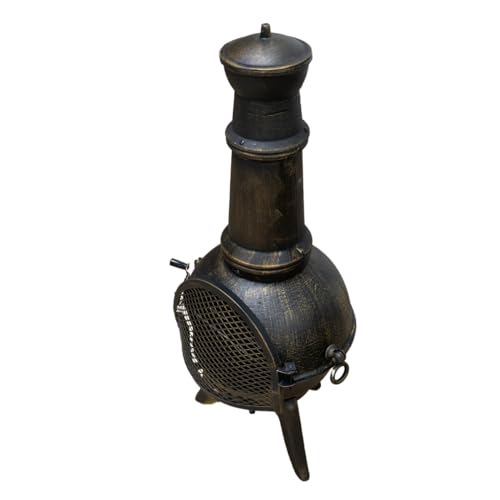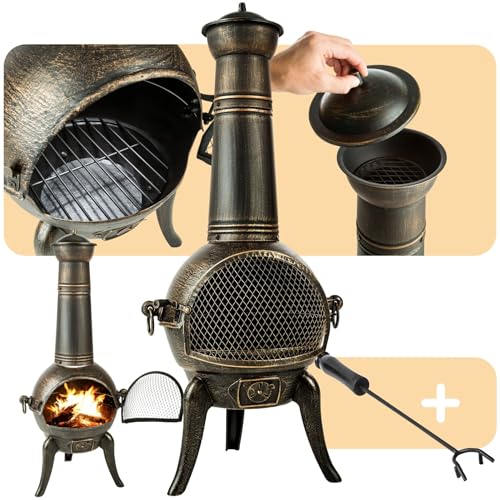15 Strange Hobbies That Will Make You More Effective At Outdoor Chimin…
페이지 정보
작성자 Stormy 댓글 0건 조회 7회 작성일 24-10-25 19:17본문
 How to Safely Maintain an Outdoor Chiminea
How to Safely Maintain an Outdoor Chiminea Chimineas for outdoor use add warmth and ambience to your garden or patio. They're also better suited for smaller areas than traditional fire pits.
Chimineas for outdoor use add warmth and ambience to your garden or patio. They're also better suited for smaller areas than traditional fire pits.Chimineas should be set on a surface that is fireproof like a patio made of concrete, bricks or stones. They should not be placed near eaves or any other overhead cover that can catch fire.
Types
A chiminea, also known as an outdoor firepit, is a kind of firepit that has an elongated chimney and a the hood that lets smoke flow upwards instead of out. Chimineas are made of clay or metal and are available in a variety of styles to suit almost any garden decor. Chimineas can also be designed to cook on the stove, which can help you prepare delicious home-cooked meals or have a snack outside while talking with friends and family.
There are a variety of wood that can be burned in a fire chiminea. Oak is a popular choice because it produces lots of heat and burns slow, but other hardwoods can be used in your chiminea. Apple is a great option because it burns slowly, has an appealing scent and is a versatile choice. Other options include cedar wood, mesquite, hickory, and pinon. These are aromatic and give off a pleasant smoke.
Metal chimineas provide more design options than traditional terra-cotta varieties and are less prone to damage caused by rain. However, they can also be susceptible to corrosion and are typically heavier than clay models. Some chimineas made of metal are coated in rust-resistant paint that helps to prevent them from deteriorating. Others are made of cast iron, which offers a classic rustic style however it is also the most heavy of all options.
It is essential to prepare your chiminea before lighting an fire. This involves the layer of gravel or sand at the bottom. This will prevent ash from spilling out and causing damage to the base. Add a few pieces of wood and some kindling. When the paper starts to burn it creates sparks that ignite the rest of your kindling, and then starts the fire.
While a chiminea can be positioned in the middle of your garden, it is best to keep it far from any plants or structures. You should also leave plenty of open space around it in the event that it tip over or gets too hot. It is also essential to cover the chimney with a metal mesh to prevent ash and sparks from flying into flammable materials.
Materials
Your chiminea, whether it's made from clay or cast iron should be made of durable materials that can withstand heat. It is also important to make sure your chiminea is specifically designed for your space and can be easily moved and stored. It is also important to know how much smoke the chiminea produces in order to cause a nuisance to neighbors.
The type of wood that you use will determine the amount of heat and duration of your chiminea. A serious chimenea user would not think of burning softwoods like pine or cedar, and instead will go for more dense, hard woods like cherry, apple walnut, hickory, walnut and oak. Hardwoods generate more heat and burn more efficiently than softwoods.
While some may prefer the look of the traditional clay chiminea, you can also find contemporary and contemporary cast aluminum chimineas that have modern lines and geometric designs. These models are lighter and can be used with both wood and gas fires. They are a versatile option for outdoor spaces.
Both clay and cast-iron chimineas need to be maintained including cleaning them and reseasoning them at intervals. They should always be placed on a solid, safe base, such as concrete tile, terracotta, or leveled sand. Avoid water around the chiminea since it could damage metal and cause cracks in clay or terracotta.
The first seasoning of the chiminea is to ignite several small fires, allow them to cool, and then light another. This will increase the heat resistance of your chiminea, resulting in longevity and greater resistance to heat. If you don't do this step, your chiminea may break or crack during its first use. It is also a good idea to protect your chiminea in the winter months or when it won't be used frequently because it protects it from rain and snow that could cause damage to it. If you're concerned about the safety and performance of your chiminea then look into a model with a spark-resistance device. This will help prevent dangerous sparks.
Design
Chimineas can be a beautiful and versatile outdoor fire feature. It is essential to keep in mind that, just like any other fireplace that burns wood it must be maintained in a way that will prevent damage and ensure the safety of the people who use the flames. By using protective covers and proper cleaning methods can make a huge difference in the life of your chiminea decorated.
Chimineas come in a wide range of styles, materials and sizes to satisfy a variety of aesthetic preferences and functional needs. Terracotta clay chimineas are classic and have a classic Mexican-inspired style. Metal chimineas are less prone to damage and offer an elegant, modern appearance.
The position of your chiminea's location is important. The chiminea's location in an open space encourages airflow, which increases efficiency and creates a cozy atmosphere around the fire. In addition, positioning it away from patio covers and overhangs prevents the buildup of smoke that could harm the structures.
If your chiminea for the garden has a chimney consider protecting it with a mesh screen to limit the amount of sparks that fly through the air. To create a barrier, try using an item or a small-holed fence bent slightly inward. Alternately, you can purchase a screen made from ceramic tile, which is designed to catch sparks and then drop them below the stack.
Although it might be tempting to use accelerants such as gasoline or lighter fluid to start a fire these chemicals can damage your chiminea if they add too much heat too quickly. The walls could cause them to crack or break resulting in injuries if not a lot and a ruined chiminea best. Accelerants can cause the chiminea's walls to break or shatter, resulting in injuries at the worst and a ruined chiminea at best.
It is possible to season your chiminea with three or four small fires. This will allow the chiminea heal and result in less cracks and less chance of explosions. It is also a good idea to not to burn anything other than well-seasoned, dried hardwood inside your chiminea.
Safety
Chimineas allow you to have a great time outdoors with your family and friends. But, as with any other outdoor flame, they can be a risk to people and property. There are some safety precautions you need to follow to ensure that you and your loved ones get to enjoy the warmth of your chiminea with no worry of an unintentional fire or accident.
To ensure your chiminea's safety it is recommended to first set it on a non-flammable surface such as pavers, bricks, or cement. This prevents the chiminea and bbq falling over and minimizes the risk of it igniting anything nearby on the fire.
Use only dry and seasoned wood for your Chiminea. Wet wood will not burn as well and could cause the chiminea or the contents to smoke. A spark arrestor is another essential component for a chiminea. It can be as simple as an ad-hoc piece of chicken wire twisted over the top of the chimney stack, or as intricate as a custom screen chimney insert. A spark arrestor prevents sparks from exploding into the neighbor's yard or onto flammable materials like bushes and grass.
Lastly, be sure to keep your chiminea 30 feet away from any fire-prone, including buildings, trees, sheds, clothes lines and awnings. This will prevent an accidental fire that could damage your property or home.
Once your chiminea bbq has been put set and you've followed all the precautions mentioned above, it's time to enjoy the warm glow and radiant heat! Remember to start small fires using only kindling and slowly increase the size of the wood. Keep a set of fireplace tools on hand to add logs to the fire and stoke it so that you don't need to get close to it. It is also a good idea to wear long barbecue tongs when working with the hot grate or coals, and a pair of gloves for fire. This will make it easier to operate the chiminea without burning your hands.
댓글목록
등록된 댓글이 없습니다.